The First National Bank Of Clayton
The First National Bank Of Clayton in New Mexico printed $586,650 dollars worth of national currency. That is a high amount, but condition and serial numbers can make otherwise common currency from this bank quite valuable. This national bank opened in 1901 and stopped printing money in 1924, which equals a 24 year printing period. That is a fairly normal lifespan for a national bank. During its life, The First National Bank Of Clayton issued 12 different types and denominations of national currency. We have examples of the types listed below. Your bank note should look similar. Just the bank name will be different. For the record, The First National Bank Of Clayton was located in Union County. It was assigned charter number 5713.
We buy all national currency. Please call or email us for a quote. Sales@AntiqueMoney.com
The First National Bank Of Clayton in New Mexico printed 2,875 sheets of $5 1882 territorial brown back national bank notes. Many territorial banks had outputs in the 2,000 to 4,000 range. 1882 five dollar territorial brown backs are the lifeblood of the territorial collecting community. They were issued by virtually every territory (with exception of Alaska, Nebraska, and Porto Rico). A total of 109 national banks printed $5 brown back territorials. There are around 120 notes known to exist. That is a pretty high survival rate. Ironically though, the fact that lots of these exist is part of the reason that they are so collectible. More than one collector can reasonably try to put together a set. Ultra-rarities are always expensive, but often times they end up as outliers to collections. 1882 five dollar brown backs have always been popular. When you combine that with the appeal of a territorial, then you have a real winner. You can contact us to learn the true value and rarity of your note. In the meantime, take the number of sheets printed and multiply it by four, that will give you the total number of 1882 $5 territorials issued.
Series of 1882 $5 Territorial Brown Back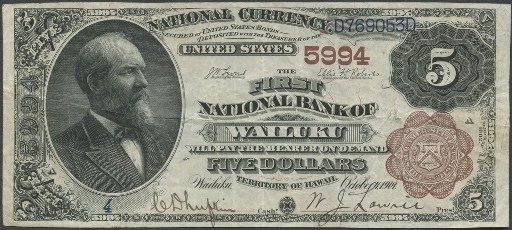
The First National Bank Of Clayton printed 2,080 sheets of $10 1882 territorial brown back national bank notes. Many territorial banks had outputs in the 2,000 to 4,000 range. The ten dollar 1882 territorial brown back was printed by more than 200 national banks, and more than 200 pieces are known to exist today. That number tends to go up by a handful each year as more are discovered. Often times the $10 territorial was the first and lowest denomination a bank received. About a dozen #1 specimens are held by collectors today, and there are probably many more still held by descendants of early pioneer bankers. Territorial bank notes are the cream of the crop when it comes to national bank notes. Most are at least rare and some can be very valuable. As always, the exact value is still based on bank of issue and condition. Something ugly from Oklahoma might only be worth $3,000, but other examples could be worth well over $10,000.
Series of 1882 $10 Territorial Brown Back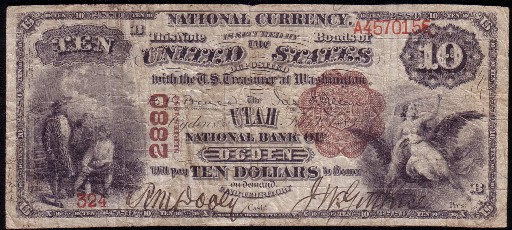
The First National Bank Of Clayton also printed 2,080 sheets of $20 1882 territorial brown back national bank notes. That number also represents the total number of twenty dollar bills printed for the type. Whether you have a ten or a twenty dollar territorial brown back, you should work with an expert to establish the value. Twenty dollar notes from this series were only printed at the rate of one to three compared to tens, but sadly, $20 1882 brown backs really don’t command a premium for their extra rarity. Only around fifty are known to exist today.
Series of 1882 $20 Territorial Brown Back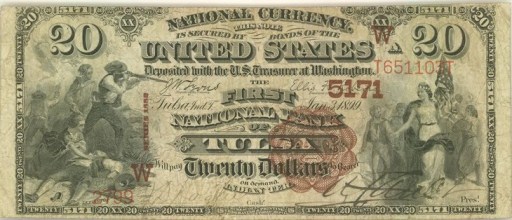
The First National Bank Of Clayton also printed 2,350 sheets of $5 1882 territorial blue seal national bank notes. Many territorial banks had outputs in the 2,000 to 4,000 range. All large size five dollar national bank notes were printed on a sheet with four notes per sheet. So you can take the sheet number and multiply it by four to get the total number of bank notes issued for 1882 $5 blue seal territorials. Right now there are over 30 of these notes known to exist. Most of that number is made up of notes from Honolulu. Only eight banks in the country even issued this type. The design looks similar to the earlier 1882 brown backs. James Garfield is on the left hand side of the note. Instead of a brown overprint, 1882 date backs have a blue seal. The back of each note says “1882 – 1908” and that is where the nickname “date back” originates.
1882 Blue Seal $5 Territorial National Bank Note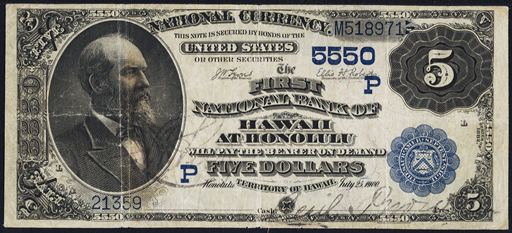
The First National Bank Of Clayton also printed 1,480 sheets of $10 1882 territorial blue seal national bank notes. A total sheet output in the lows 1,000s is a great sign that you own a very rare bank note. You can take that sheet number and multiply it by three to get the exact number of 1882 $10 territorial date backs issued by this bank. Only sixteen different banks even printed this exotic issue. The reason for such a low output has to do with timing. 1882 date backs were not issued until 1908. The only places that were still in territorial status at the time were New Mexico, Arizona, Alaska, and Hawaii. Furthermore, to even qualify to issue these notes the bank had to have been opened between 1888 and 1901. You can see why only sixteen banks ended up printing ten dollar bills like this. Most people who aren’t collectors aren’t entirely sure if they have a territorial or not because non-territorials look exactly the same. Just look below the bank’s title. If it says Territory or Ter before the name of the state, then you have a territorial.
1882 Blue Seal $10 Territorial National Bank Note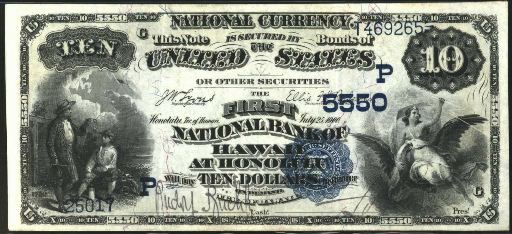
The First National Bank Of Clayton also printed 1,480 sheets of $20 1882 territorial blue seal national bank notes. There was just one twenty dollar bill on each sheet of bank notes. So the sheet number is the same as the individual note output. Currently there are about a dozen 1882 $20 blue seals known to exist. Most of that total is from Hawaii, but Arizona, Alaska, and New Mexico each have single examples to represent the state (or in this case, territory). The design of these notes is just like any other 1882 $20 date back. The left hand side of the note has a man pointing a rifle. The right hand side shows lady liberty or Columbia holding a flag.
1882 Blue Seal $20 Territorial National Bank Note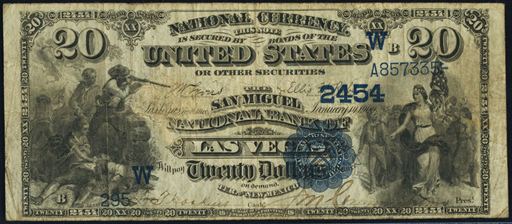
The First National Bank Of Clayton also printed 3,715 sheets of $5 1882 blue seal national bank notes. That is a pretty standard sheet output number for these issues. Most of the value is going to be in the condition. 1882 $5 blue seal bank notes were issued by some national banks in The United States. While these are a somewhat rarer issue, they just aren’t especially popular with collectors. With exception of some minor differences, they look exactly like the earlier brown back series. Most collectors would prefer the brown back notes. With that said, some 1882 blue seals can still be worth thousands of dollars. So don’t just assume that what you have is automatically common.
1882 Blue Seal $5 National Bank Note
The First National Bank Of Clayton also printed 2,323 sheets of $10 1882 blue seal national bank notes. 1882 blue seals are traditionally not the most popular national bank notes. However, when we are talking about such a low print number, these become much more desirable. All of these notes say series of 1882 but they were actually printed between 1908 and 1921. So they aren’t quite as old as the dates might suggest. There is also a date on these notes that is between 1888 and 1901. That date is written in cursive text and it represents when the bank was chartered or re-chartered. Some of the so called 1882 value back notes have a chance to be really rare. Most of the earlier notes that say 1882-1908 on the back are likely going to be relatively common. The designs are exactly the same on the front. Each has a blue seal and charter number.
1882 Blue Seal $10 National Bank Note
The First National Bank Of Clayton also printed 2,323 sheets of $20 1882 blue seal national bank notes. That is the same number of sheets as the ten dollar denomination. You don’t have to multiply by three to get the exact number of notes issued though. There was only one twenty dollar bill per sheet. As with any national bank note, the exact value is still based on the condition, serial number, and bank of issue.
1882 Blue Seal $20 National Bank Note
The First National Bank Of Clayton also printed 2,355 sheets of $5 1902 blue seal national bank notes. Most banks that printed such a small number of blue seal bank notes fall into the rare bank category. Ben Harrison is on the front of all 1902 $5 blue seal bank notes. This happens to be the smallest denomination issued for the 1902 series. Each note is complete with a blue seal and blue charter number. Despite saying series of 1902, these were actually issued by national banks between 1908 and 1928. There are two different types of blue seals. The first type is called a date back and it has “1902-1908” written on the back of the bill. The other type is called a plain back; it does not have the date stamps on the back of the bill. The values for these notes range widely based on condition and the bank of issue.
1902 $5 Blue Seal National Bank Note
The First National Bank Of Clayton also printed 1,332 sheets of $10 1902 blue seal national bank notes. Most banks that printed such a small number of blue seal bank notes fall into the rare bank category. 1902 $10 blue seal bank notes all have a portrait of William McKinley on them. Values can range from as little as $40 up to over $10,000. There really is no trick to know what is rare and what is common by just doing an internet search. You really need to work with an expert (like us) in order to determine the value of your specific bank note. There are at least ten different factors than can make some 1902 $10 blue seals worth more than others. We know exactly what to look for and we would be happy to provide a free appraisal and our best offer.
1902 $10 Blue Seal National Bank Note
The First National Bank Of Clayton also printed 1,332 sheets of $20 1902 blue seal national bank notes. The same rarity rules for 1902 $10 blue seals also apply to $20 blue seals. Just remember that $20 bills are by nature three times rarer (unfortunately they don’t command a premium over other denominations). Hugh McCulloch is pictured on the front of each bill. Contact us if you need pricing help.
1902 $20 Blue Seal National Bank Note



